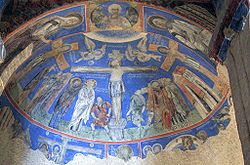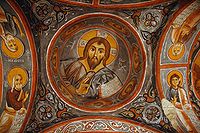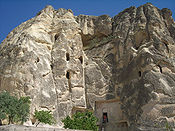
Churches of Göreme, Turkey
Encyclopedia

Göreme
Göreme , located among the "fairy chimney" rock formations, is a town in Cappadocia, a historical region of Turkey. It is in the Nevşehir Province in Central Anatolia and has a population of around 2,500 people....
is a district of the Nevşehir Province
Nevsehir Province
Nevşehir Province is a province in central Turkey with its capital in Nevşehir. It adjacent provinces are Kırşehir to the northwest, Aksaray to the southwest, Niğde to the south, Kayseri to the southeast, and Yozgat to the northeast. Nevşehir includes the area called Cappadocia - a very popular...
in Turkey
Turkey
Turkey , known officially as the Republic of Turkey , is a Eurasian country located in Western Asia and in East Thrace in Southeastern Europe...
. After the eruption of Mount Erciyes
Mount Erciyes
Mount Erciyes is a massive stratovolcano located 25 km to the south of Kayseri in Turkey.Erciyes is the highest mountain in central Anatolia, with its summit reaching...
about 2,000 years ago, ash and lava formed soft rocks in the Cappadocia
Cappadocia
Cappadocia is a historical region in Central Anatolia, largely in Nevşehir Province.In the time of Herodotus, the Cappadocians were reported as occupying the whole region from Mount Taurus to the vicinity of the Euxine...
Region, covering a region of about 20,000 km2. The softer rock was eroded by wind and water, leaving the hard cap rock on top of pillars, forming the present-day fairy chimneys. People of Göreme, at the heart of the Cappadocia Region, realized that these soft rocks could be easily carved out to form houses, churches, monasteries. These Christian sanctuaries contain many examples of Byzantine art
Byzantine art
Byzantine art is the term commonly used to describe the artistic products of the Byzantine Empire from about the 5th century until the Fall of Constantinople in 1453....
from the post-iconoclastic period
Iconoclasm (Byzantine)
The Byzantine Iconoclasm encompasses two periods in the history of the Byzantine Empire when Emperors, backed by imperially-appointed leaders and councils of the Orthodox Church imposed a ban on religious images or icons. The "First Iconoclasm", as it is sometimes called, lasted between about 730...
. These frescoes are a unique artistic achievement from this period.
In the 4th century small anchorite
Anchorite
Anchorite denotes someone who, for religious reasons, withdraws from secular society so as to be able to lead an intensely prayer-oriented, ascetic, and—circumstances permitting—Eucharist-focused life...
communities began to form in the region, acting on instruction of Saint Basil of Caesarea
Basil of Caesarea
Basil of Caesarea, also called Saint Basil the Great, was the bishop of Caesarea Mazaca in Cappadocia, Asia Minor . He was an influential 4th century Christian theologian...
. They carved cells in the soft rock. During the iconoclastic period (725-842) the decoration of the many sanctuaries in the region was held to a minimum, usually symbols such as the depiction of the cross. After this period, new churches were dug into the rocks and they were richly decorated with colourful fresco
Fresco
Fresco is any of several related mural painting types, executed on plaster on walls or ceilings. The word fresco comes from the Greek word affresca which derives from the Latin word for "fresh". Frescoes first developed in the ancient world and continued to be popular through the Renaissance...
es.
Tokalı Kilise

One noted feature of the church is the main nave containing ninth century fresco
Fresco
Fresco is any of several related mural painting types, executed on plaster on walls or ceilings. The word fresco comes from the Greek word affresca which derives from the Latin word for "fresh". Frescoes first developed in the ancient world and continued to be popular through the Renaissance...
es in "provincial" style, the more recent additions are three apses of the 11th century frescoes, which are rendered in "metropolitan" style. The church contains frescoes of the twelve apostles, the saints and scenes from the life of Jesus (963-969 and 11th century respectively). The church also has a crypt underneath the nave. The Buckle Church is formed of four chambers: the Old Church, the larger New Church, the Paracclesion, and the Lower Church. The Old Church dates to the 10th century. It was originally a single-naved barrel-vaulted church. But its apse was destroyed when the New Church was added at the end of the 10th or early 11th century. Now the Old Church provides entrance to the New Church. The Old Church is decorated with pale hues of red and green painted in strips to represent scenes from the New Testament
New Testament
The New Testament is the second major division of the Christian biblical canon, the first such division being the much longer Old Testament....
and depictions of some saints. Panels of rich indigo painted with pigments from the lapis lazuli
Lapis lazuli
Lapis lazuli is a relatively rare semi-precious stone that has been prized since antiquity for its intense blue color....
stone dominate the New Church : scenes from the New Testament, miracles of Christ, the first deacons, episodes from the life of St. Basil
Basil of Caesarea
Basil of Caesarea, also called Saint Basil the Great, was the bishop of Caesarea Mazaca in Cappadocia, Asia Minor . He was an influential 4th century Christian theologian...
(one of the Cappadocian Fathers
Cappadocian Fathers
The Cappadocian Fathers are Basil the Great , who was bishop of Caesarea; Basil's brother Gregory of Nyssa , who was bishop of Nyssa; and a close friend, Gregory of Nazianzus , who became Patriarch of Constantinople...
), depictions of Leades (one of the Forty Martyrs) and St. Menas. The New Church was carved out of the eastern wall of the Old Church and decorated with Eastern-style arches and a series of arcades. The Paracclesion, located at the left side of the New Church, is a barrel-vaulted chapel with a single apse. The Lower Church has three aisles and a burial space or krypto.
Elmalı Kilise
Elmalı Kilise (or the Apple Church) a smaller cave church. Was built around 1050 and has carved into four irregular pillars the sign of a Greek cross with these pillars support its central dome. Restoration on the church was completed in 1991, but the frescoes continue to chip off, revealing a layer of earlier paintings underneath. The church's paintings depict scenes of the saints, bishops, and martyrs. and to the right of the altar, a Last Supper with the symbolic fish (the letters of the word fish in Greek, ΙΧΘΥΣ, stand for "Jesus Christ, Son of God, the Savior"). The name of the church is believed to refer to a reddish orb in the left hand of the Archangel Michael in the dome of the main apse, or possibly to an apple tree that grew in the vicinity.Azize Barbara Kilisesi

Saint Barbara
Saint Barbara, , Feast Day December 4, known in the Eastern Orthodox Church as the Great Martyr Barbara, was an early Christian saint and martyr....
) Barbara was an Egyptian martyr
Martyr
A martyr is somebody who suffers persecution and death for refusing to renounce, or accept, a belief or cause, usually religious.-Meaning:...
who was imprisoned by her father in order to protect her from the influences of Christianity.
Barbara nevertheless found a way to practice her faith and her father tortured and killed her.
Built in the late 11th Century, the church was possibly built as a tribute to the Martyr-Saint. The church has the same layout as Çarikli Kilise. The church has a cross-dome with one central apse
Apse
In architecture, the apse is a semicircular recess covered with a hemispherical vault or semi-dome...
, two side apses and two columns. The dome depicts Christ on the Throne, with geometrical patterns painted in red ochre
Ochre
Ochre is the term for both a golden-yellow or light yellow brown color and for a form of earth pigment which produces the color. The pigment can also be used to create a reddish tint known as "red ochre". The more rarely used terms "purple ochre" and "brown ochre" also exist for variant hues...
, painted directly on the rock, believed to be symbolic in nature. Another fresco with the large locust possibly representing evil, which is warded off by the protection of two adjacent crosses. The north wall of the church contains a fresco of St. George and St Theodore on horse-back struggling against the dragon and snake. The monks drew red ochre lines on the rocks, to give the impression that cut stones were used in the construction.
Yilanlı Kilise
_church.jpg)
Saint Helena
Saint Helena , named after St Helena of Constantinople, is an island of volcanic origin in the South Atlantic Ocean. It is part of the British overseas territory of Saint Helena, Ascension and Tristan da Cunha which also includes Ascension Island and the islands of Tristan da Cunha...
depicted holding the "True Cross
True Cross
The True Cross is the name for physical remnants which, by a Christian tradition, are believed to be from the cross upon which Jesus was crucified.According to post-Nicene historians, Socrates Scholasticus and others, the Empress Helena The True Cross is the name for physical remnants which, by a...
." Legend has it that she discovered the cross upon which Jesus was crucified after seeing it in a dream, and that a piece of the cross is still buried in the foundations of the Hagia Sophia
Hagia Sophia
Hagia Sophia is a former Orthodox patriarchal basilica, later a mosque, and now a museum in Istanbul, Turkey...
in Istanbul
Istanbul
Istanbul , historically known as Byzantium and Constantinople , is the largest city of Turkey. Istanbul metropolitan province had 13.26 million people living in it as of December, 2010, which is 18% of Turkey's population and the 3rd largest metropolitan area in Europe after London and...
. Other sections of the cross are in the Church of the Holy Sepulchre and in St. Peter's in Rome. Another interesting portrait is the one of Saint Onuphrius on the upper wall to the right of the entrance. The saint lived the life of a hermit in the Egyptian desert near Thebes, Egypt
Thebes, Egypt
Thebes is the Greek name for a city in Ancient Egypt located about 800 km south of the Mediterranean, on the east bank of the river Nile within the modern city of Luxor. The Theban Necropolis is situated nearby on the west bank of the Nile.-History:...
and is usually depicted with a long gray beard and wearing only a fig leaf.
Karanlık Kilise

Christ Pantocrator
In Christian iconography, Christ Pantokrator refers to a specific depiction of Christ. Pantocrator or Pantokrator is a translation of one of many Names of God in Judaism...
, Nativity, Adoration of the Magi, First Bath, Last Supper, Betrayal of Judas, Crucifixion, Anastasis.
After the Turkish invasion it was used as a pigeon house until 1950s. After 14 years of scraping pigeon droppings off the walls, these newly restored frescoes, depicting scenes from the New Testament
New Testament
The New Testament is the second major division of the Christian biblical canon, the first such division being the much longer Old Testament....
, are the best preserved in all of Cappadocia
Cappadocia
Cappadocia is a historical region in Central Anatolia, largely in Nevşehir Province.In the time of Herodotus, the Cappadocians were reported as occupying the whole region from Mount Taurus to the vicinity of the Euxine...
and a fine example of 11th-century Byzantine
Byzantine
Byzantine usually refers to the Roman Empire during the Middle Ages.Byzantine may also refer to:* A citizen of the Byzantine Empire, or native Greek during the Middle Ages...
art. Part of the narthex or vestibule however collapsed opening part of the church's roof to the sky. This caused damage to the fresco with Christ’s Ascension and the Benediction of the Saints, whereas the other scenes only partially remain where the wall collapsed. The church's name possibly comes from a small oculus
Oculus
An Oculus, circular window, or rain-hole is a feature of Classical architecture since the 16th century. They are often denoted by their French name, oeil de boeuf, or "bull's-eye". Such circular or oval windows express the presence of a mezzanine on a building's façade without competing for...
looking out of the narthex
Narthex
The narthex of a church is the entrance or lobby area, located at the end of the nave, at the far end from the church's main altar. Traditionally the narthex was a part of the church building, but was not considered part of the church proper...
which only lets in a very small amount of light. This feature is what has preserved the richness of the pigments and allowed them to survive the passage of time.
Çarıklı Kilise

Church of the Ascension
-England:*The Ascension, Lavender Hill*Church of the Ascension, Hall Green*Church of the Ascension, Hulme-Israel:*Chapel of the Ascension , claimed to the early tradition...
in Jerusalem). The church is cut into the same rock as Karanlik Kilise. The footprints themselves, have many unconfirmable legends attached to them. The church is carved into a cross floor plan with intersecting vaults. The church's frescoes, which date to the 11th century, contain the four Evangelists, the Nativity and the Crucifixion, the Baptism, the Adoration of the Magi, and other New Testament themes.
See also
- DemreMyraMyra is an ancient town in Lycia, where the small town of Kale is situated today in present day Antalya Province of Turkey. It was located on the river Myros , in the fertile alluvial plain between Alaca Dağ, the Massikytos range and the Aegean Sea.- Historical evidence :Although some scholars...
- Derinkuyu Underground CityDerinkuyu Underground CityDerinkuyu Underground City is an ancient multi-level underground city in the Derinkuyu district in Nevşehir Province, Turkey.With its eleven floors extending to a depth of approximately 85 m, it was large enough to shelter tens of thousands of people together with their livestock and food stores...
- EphesusEphesusEphesus was an ancient Greek city, and later a major Roman city, on the west coast of Asia Minor, near present-day Selçuk, Izmir Province, Turkey. It was one of the twelve cities of the Ionian League during the Classical Greek era...
- Kaymaklı Underground CityKaymakli Underground CityKaymaklı Underground City is contained within the citadel of Kaymaklı in the Central Anatolia Region of Turkey. First opened to tourists in 1964, the village is about 19 km from Nevşehir, on the Nevşehir-Niğde road. The ancient name was Enegup. The houses in the village are constructed around...
- Kuştul MonasteryKustul MonasteryKuştul Monastery is located near Şimşirli village, Maçka district, Trabzon Province, Turkey. Founded in 752 CE at 30 km southeast of Trabzon, it was finally closed on January 17, 1923, when the monks along with other Greeks were expelled to Greece. After 1906 fire, it was restored...
- Last House of the Virgin MaryHouse of the Virgin MaryThe House of the Virgin Mary is a Christian and Muslim shrine located on Mt...
- MokissosMokissosMokissos is the formal name for a now inactive Diocese of the Greek Orthodox Church.Mokissos was an ancient Byzantine city , located in western Cappadocia at the foot of what is now known as the Hasan Dag, southeast of Koloneia...
- Monastery of MardinMardinMardin is a city in southeastern Turkey. The capital of Mardin Province, it is known for its Arabic-like architecture, and for its strategic location on a rocky mountain overlooking the plains of northern Syria.-History:...
- Spiro KostofSpiro KostofDr. Spiro Konstantine Kostof was a leading architectural historian and inspirational teacher at the University of California, Berkeley. His books continue to be widely read and some are routinely used in collegiate courses on architectural history.A Bulgarian born in Turkey, Kostof was educated...
- Sümela MonasterySumela MonasteryThe Sümela Monastery , , i.e. monastery of the Panaghia at Melá mountain) is a Greek Orthodox monastery, standing at the foot of a steep cliff facing the Altındere valley, in the region of Maçka in Trabzon Province, modern Turkey...
- Underground cities in AvanosAvanosAvanos , is a town and district of Nevşehir Province in the Central Anatolia region of Turkey, located north of Nevşehir, the capital city of the province. It is situated within the historic and touristic region of Cappadocia. According to 2000 census, population of the district is 35,145 of which...
Further reading
- Caves of God: Cappadocia and its Churches by Spiro Kostof Publisher: Oxford University Press, USA (August 3, 1989) ISBN 0195060008 ISBN 978-0195060003

